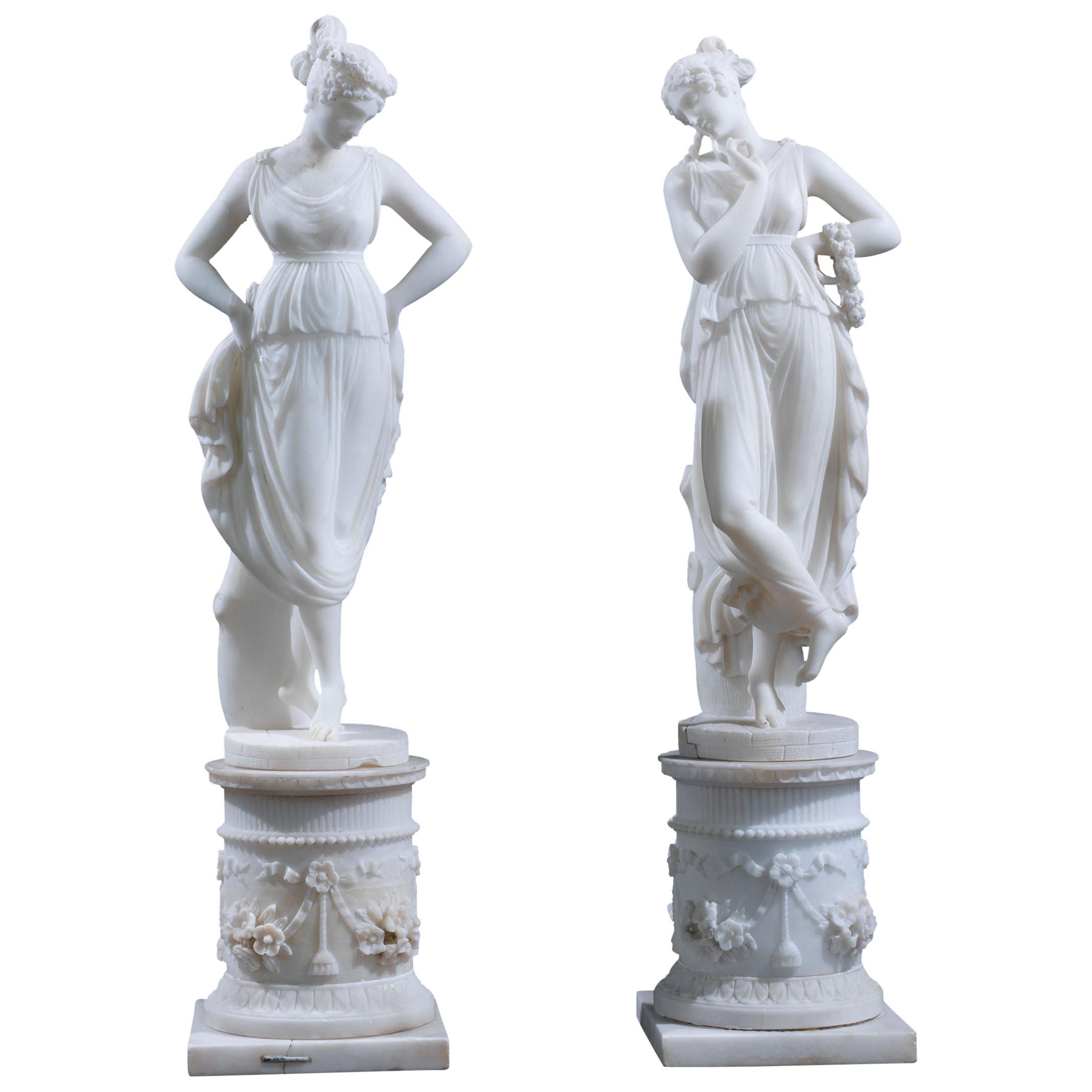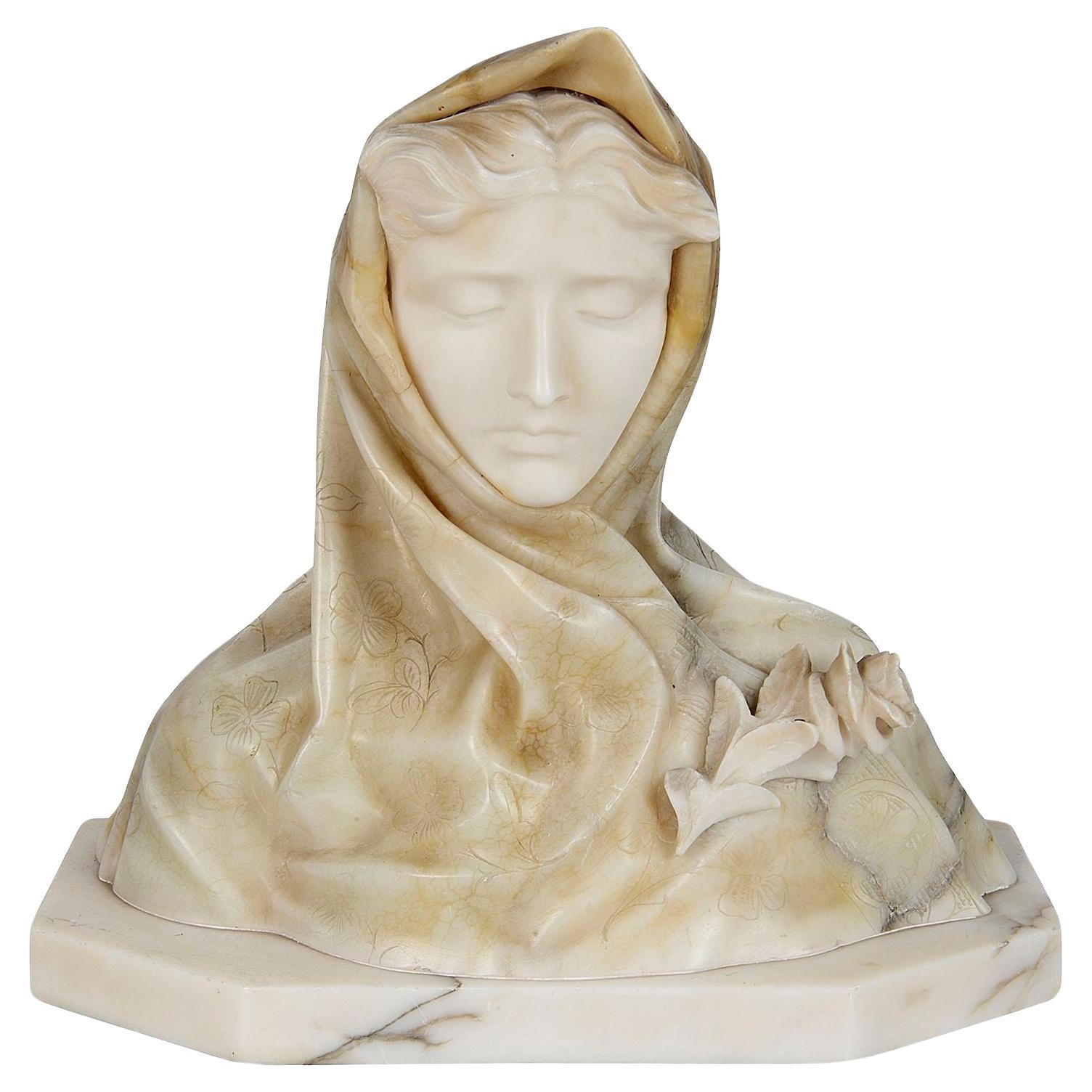Items Similar to 19th Century Pair of Desks with portraits of Petrarch and Leonardo Alabaster
Want more images or videos?
Request additional images or videos from the seller
19th Century Pair of Desks with portraits of Petrarch and Leonardo Alabaster
About the Item
19th century
Pair of desks with portraits of Petrarch and Leonardo
(2) Alabaster, 34 and 35 cm diam
The pair of alabaster discs features a central cameo with the effigy of Petrarch and Leonardo, probably part of a larger series that featured illustrious characters from Italian history. On the openwork frame of Petrarch there are portraits of some characters who face each other, combined for centuries, as can be seen from the shapes of the garments that span several centuries: from the thirteenth century, in which men wear long-tipped bonnets, to the fifteenth century and Sixteenth century, the two characters at the top, in the seventeenth century, with wide collars, up to the eighteenth century.
Francesco Petrarca (1304-1374) embodies the figure of the humanist intellectual par excellence, entirely dedicated to the study of Latin conceived as the only form of expression worthy of a man of letters, so as to serve any form of written communication, including letters and the reflection on himself witnessed in the Secretum. A personality made more complex by obsessive perfectionism, which led him to a continuous and infinite editing of the work which he also flaunted to consider as minor and which instead ensured him an undying fame among posterity, the Canzoniere. But the only aspect fixed in the collective imagination is that of the lover who idolizes the places where his ideal love blossomed and where it remained hovering after the death of his earthly object. The dimension of the memory of an unconsummated love, made of contemplation and desire, capable of transfiguring the place of encounter or vision, the longing for an ideal beauty as a poetic inspiration are the themes that attract lovers of the Petrarchian myth. The typical representation of Petrarch, as well as part of his literary fortune, ends up by grasping an absolutely marginal and partly strongly deviant aspect of the public and sought-after image of the great man of letters.
Leonardo da Vinci was born in 1452 and died in Amboise in 1519). He personified the Renaissance genius that revolutionized both the visual arts and the history of thought and science. He presents himself with a letter that represents a kind of curriculum in which he describes his aptitudes as a civil engineer and builder of war machines to the Duke of Milan Lodovico Sforza, who welcomed him well. Here the pictorial masterpieces are born: the Virgin of the Rocks in the two versions of Paris and London and the exercise for the bronze equestrian monument to Francesco Sforza. In 1489-90 he prepared the decorations of the Castello Sforzesco in Milan for the wedding of Gian Galeazzo Sforza with Isabella of Aragon while, as a hydraulic engineer, he took care of the reclamation in the lower Lombardy region. In 1495 the fresco of the Cenacle begins in the church of Santa Maria delle Grazie. In 1499 Leonardo escaped from Milan because it was invaded by the troops of the French king Louis XII and took refuge in Mantua and Venice. In 1503 he was in Florence to fresco, together with Michelangelo, the large Council Hall in the Palazzo della Signoria. Leonardo is entrusted with the representation of the Battle of Anghiari which, however, he will not complete, due to his obsessive search for artistic techniques to be experimented or innovated. In 1513 the king of France Francis I invited him to Amboise. Leonardo will take care of projects for the celebrations and will continue with his hydrological projects for some rivers of France. In 1503 he was in Florence to fresco, together with Michelangelo, the large Council Hall in the Palazzo della Signoria. Leonardo is entrusted with the representation of the Battle of Anghiari which, however, he will not complete, due to his obsessive search for artistic techniques to be experimented or innovated. In 1513 the king of France Francis I invited him to Amboise. Leonardo will take care of projects for the celebrations and will continue with his hydrological projects for some rivers of France. In 1503 he was in Florence to fresco, together with Michelangelo, the large Council Hall in the Palazzo della Signoria. Leonardo is entrusted with the representation of the Battle of Anghiari which, however, he will not complete, due to his obsessive search for artistic techniques to be experimented or innovated. In 1513 the king of France Francis I invited him to Amboise. Leonardo will take care of projects for the celebrations and will continue with his hydrological projects for some rivers of France. In 1513 the king of France Francis I invited him to Amboise. Leonardo will take care of projects for the celebrations and will continue with his hydrological projects for some rivers of France. In 1513 the king of France Francis I invited him to Amboise. Leonardo will take care of projects for the celebrations and will continue with his hydrological projects for some rivers of France.
- Dimensions:Height: 13.78 in (35 cm)Diameter: 13.78 in (35 cm)
- Sold As:Set of 2
- Materials and Techniques:
- Place of Origin:
- Period:
- Date of Manufacture:19th Century
- Condition:Wear consistent with age and use.
- Seller Location:Milan, IT
- Reference Number:1stDibs: LU5918226540562

About the Seller
5.0
Vetted Seller
These experienced sellers undergo a comprehensive evaluation by our team of in-house experts.
Established in 2000
1stDibs seller since 2021
26 sales on 1stDibs
Typical response time: 12 hours
- ShippingRetrieving quote...Ships From: Milan, Italy
- Return PolicyA return for this item may be initiated within 14 days of delivery.
More From This SellerView All
- Bust of Juliette Récamier, Alabaster, 19th centuryLocated in Milan, IT19thC Bust of Juliette Récamier Alabaster, 42 x 23 x 11 cm The sculpture depicts the bust of Jeanne Françoise Julie Adélaïde Bernard, better known as Juliette Récamier or Madame R...Category
Antique 19th Century Busts
MaterialsAlabaster
- Madonna and Child and St. John, Alabaster, 19th centuryLocated in Milan, IT19thC Madonna with Child and San Giovannino Alabaster, cm h. 29 The item is in good conditionCategory
Antique 19th Century Figurative Sculptures
MaterialsAlabaster
- 19th Century Young Woman Portrait Plaster SculptureLocated in Milan, ITNineteenth century Young woman portrait Measures: Plaster, 50 x 40 x H 40 cm Dated 10 - 1 - MCMI The emergence of a "disheveled manner" in sculpture is affirmed since the 1880s with Giuseppe Grandi, author of the Monument to the Five Days of Milan, Ernesto Bazzaro, Paolo Troubetzkoy...Category
Antique 19th Century Italian Figurative Sculptures
MaterialsPlaster
- Sculture in Bronzo Nereide e Tritone XIX secoloLocated in Milan, ITXIX secolo Nereide e Tritone (2) Bronzo e marmo, cm alt. 26,5 La coppia di sculture raffigura le divinità fluviali identificabili in Tritone, riconoscibile dallo scettro, e una dell...Category
Antique 19th Century Figurative Sculptures
MaterialsBronze
- 20th Century Reclining Woman with Sphinx Sculpture AlabasterLocated in Milan, IT20th Century Reclining woman with Sphinx Alabaster, 43 x 60 x 25 cm The sculpture depicts a young and charming odalisque lying languidly on a refined sheet. The face with d...Category
20th Century Italian Figurative Sculptures
MaterialsAlabaster
- Sculpture depicting Dante and Beatrice, Alabaster, 20th centuryLocated in Milan, ITDante and Beatrice Alabaster, 33 x 20 x 36 cm Early 20th century The present alabaster relief, of which great technical skill is evident, imitates the pages of a book, On the two...Category
20th Century Figurative Sculptures
MaterialsAlabaster
You May Also Like
- Pair 19th Century Grand Tour Alabaster LionsLocated in Seaford, GBA delightful and rare pair of 19th Century Grand Tour Alabaster Lions. Well modelled, one is virtually perfect, the other has a few nibbles see ph...Category
Antique Mid-19th Century Italian Animal Sculptures
MaterialsAlabaster
- Pair of 19th Century Italian Alabaster Classical Figures of MusesLocated in London, GBA pair of very finely carved 19th century alabaster figures of muses, in classical dress, each standing on circular pedestals intricately carved with flowers and beading, Italian, c....Category
Antique Mid-19th Century Italian Neoclassical Figurative Sculptures
MaterialsAlabaster
- Little Alabaster Dog of the 19th CenturyBy Europa AntiquesLocated in Madrid, ESLITTLE ALABASTER DOG OF THE XIX CENTURY. DOG IN MINIATURE OF THE XIX CENTURY. MEASURES: 11X11X5CM. Good condition.Category
Antique 19th Century Italian Baroque Animal Sculptures
MaterialsAlabaster
- 19th Century Italian Alabaster FigureLocated in Pasadena, CAAn Italian alabaster sculpture, circa 1860. Perfect for desktop, coffee table or bookcase accessorizing or to add to an existing collection of 19th century sculptures.Category
Antique Mid-19th Century Italian Classical Greek Figurative Sculptures
MaterialsMarble
- 19th Century Marble and Alabaster bust of young girlLocated in Brighton, SussexA late 19th Century French hand carved Alabaster and marble bust of a hooded young girl. Batch 74. TUKZ G10001/23Category
Antique Late 19th Century French Figurative Sculptures
MaterialsAlabaster, Marble
- Italian 19th Century Alabaster and Marble StatueLocated in West Palm Beach, FLAn elegant and decorative Italian 19th century alabaster and marble statue of a Greek goddess Ariadne seated on her panther. Gazing towards her left while her elbow rests on her pant...Category
Antique 19th Century Italian Figurative Sculptures
MaterialsAlabaster, Marble
Recently Viewed
View AllMore Ways To Browse
Pair Of Desks
19th Century Mens
19th Century Civil War
Pair Of Alabaster
Machine 19th
19th Century Alabaster
War Machine
Pair Of Church
Antique Frames Decorative Arts
19th Century Portrait Pair
Pair Of 19th Century Portraits
Large Antique Letters
French Pair Portraits
Bonnet Top Furniture
19th Century Italian Alabaster
19th Century Alabaster Sculpture
Effigy Sculpture
Francis I Furniture





